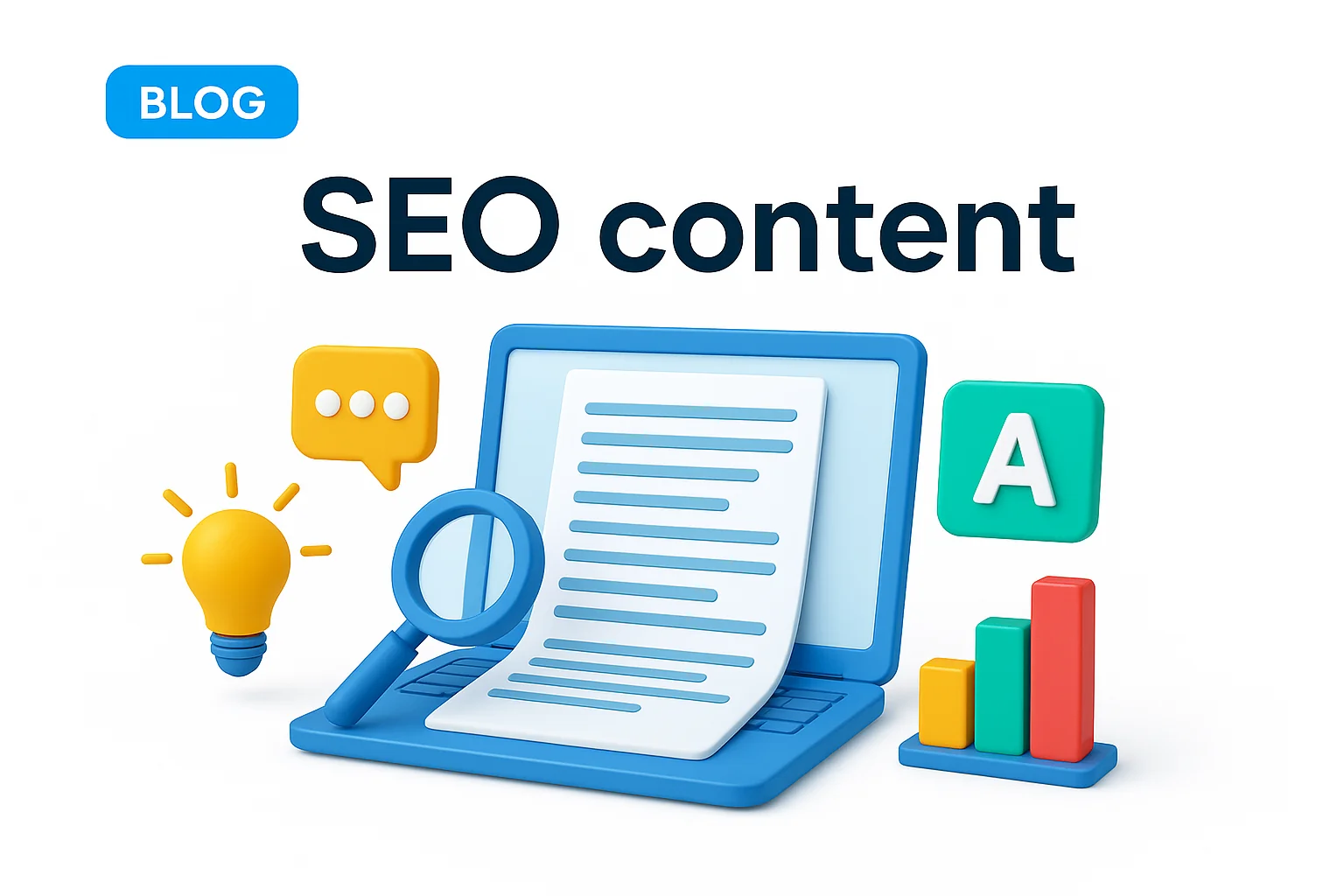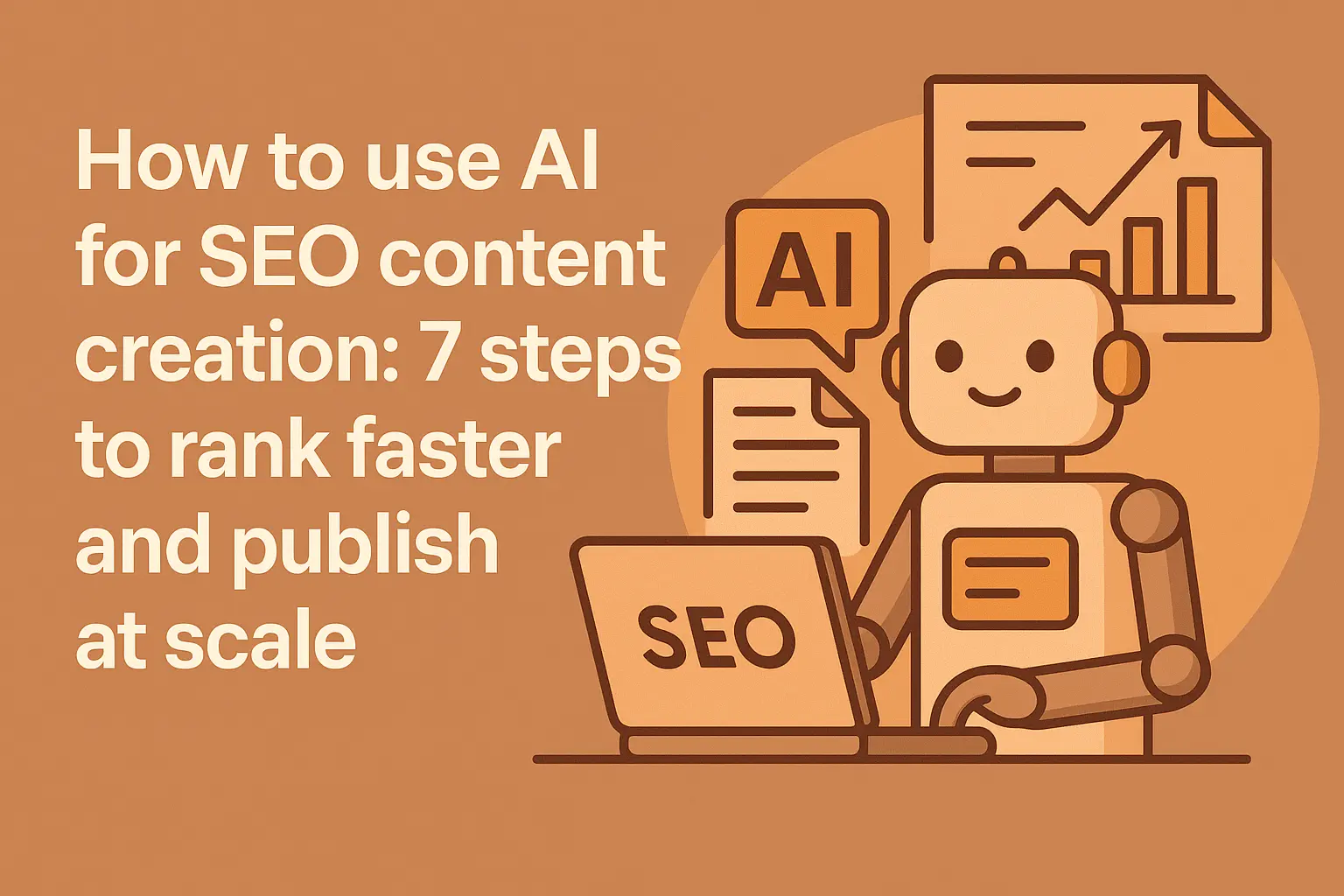how to create AI SEO content without sacrificing quality
Generate publish-ready SEO content faster without sacrificing quality. Factor 6 learns your brand voice, prioritizes search intent, and scales content.

What is SEO content?
SEO content is content built to rank and convert. It answers search intent precisely, earns visibility through relevance and authority, and moves readers toward action with clear structure and UX. High-performing SEO content balances research, information gain, and brand voice so every page serves the user and the business.
Teams often ask if AI can help. Yes, when guided by strategy: map keywords to intent, analyze the SERP, plan an outline that adds unique value, draft with brand-trained AI, and ship with rigorous on-page SEO. Done well, AI SEO content reduces time to publish without sacrificing quality, accuracy, or performance.
Why SEO content needs strategy not templates
Templates copy what already ranks; strategy identifies what is missing. Search engines reward pages that resolve user tasks better than alternatives. That comes from understanding audience jobs to be done, not from slot-filling headings or keyword stuffing.
Approach: define the problem, study the SERP, quantify information gaps, then build an experience that is faster, clearer, and more trustworthy. Result: SEO content that is original, comprehensive, and aligned to business goals instead of generic copy.
How search intent and SERP analysis guide SEO content
Start with intent. Every query expresses a goal: learn, compare, or buy. SERP analysis shows what Google believes satisfies that goal. By reading the results, you learn the format to produce, the depth required, and the angles with highest information gain.
Use tools and judgment. Map each keyword to the dominant intent and content type, note page structures that win, and log questions competitors leave unanswered. This turns SEO content from guesswork into a predictable, repeatable process.
- Scan the SERP: types of pages, content length, media, and freshness.
- Identify intent: informational, commercial, transactional, or navigational.
- Extract recurring subtopics: headings, FAQs, comparisons, and data points.
- Spot gaps: missing use cases, outdated stats, regional nuances, or workflow detail.
Takeaway: intent dictates the format and scope. Gaps signal where your SEO content can add unique value that search engines and readers reward.
Determine intent and target content type
Informational queries prefer guides, how-tos, or definitions; commercial queries trend toward comparisons and use cases; transactional searches lean to product pages. If top results are listicles with feature tables, a long essay will underperform. If results are deep tutorials, a shallow roundup will miss the mark.
Use deep SERP and competitor research to confirm dominant intent and to pick the right format: guide, checklist, comparison, or landing page. Match the content type to the job the searcher wants done.
Identify information gaps and opportunity keywords
Information gain is the edge. Add angles the SERP lacks: implementation detail, pricing transparency, region-specific steps, or subject-matter insights. Replace filler with specifics and credible examples. Cite recognized sources when relevant to build trust.
Expand your plan with related queries and “next step” topics. Mine data-driven keyword ideas to find low-competition terms, questions with high click potential, and entities tied to your theme. Then structure your SEO content to naturally answer them.
How to create AI SEO content without sacrificing quality
AI accelerates production when it is fed the right inputs and governed by clear standards. The workflow: research the query and SERP, plan an outline that maximizes information gain, draft with AI trained on your guidelines, then edit for accuracy, UX, and on-page SEO before publishing.
This section breaks down the five steps used by teams that consistently ship AI SEO content that ranks and reflects their brand. Each step reduces manual rework and improves outcomes.
1. Research: keywords, intent, and top-ranking pages
Begin with the primary keyword, adjacent terms, and entity set. Confirm intent and volume, then study the structure of top results. Note what they cover, how they format it, and where they fall short. Pay attention to freshness, examples, and POV to define your advantage.
Build a research brief: target keyword cluster, intent, content type, entities, questions to answer, and sources to cite. Use a repeatable template so every piece of SEO content begins with the same level of rigor. Reference an AI SEO process you can run on any topic.
2. Plan: outline with information gain and headings
Translate research into a structured outline. Each H2 should map to a user outcome; each H3 should deepen a subtask or comparison. Add information gain: proprietary data, expert quotes, examples, or localized steps. Define the angle you own, not just the topics you cover.
Include metadata and UX decisions in the plan: title options that match intent, target snippet answer, scannable elements, and internal link targets. Decide on the slug now: simple, readable, and focused, such as seo-content or ai-seo-content.
3. Draft: use AI trained on brand assets and guidelines
AI needs guardrails. Load brand voice rules, audience specifics, banned phrases, and product positioning. Provide the outline, research brief, and example passages that show tone and depth. The result is AI SEO content that sounds like you and respects your strategy.
Centralize this in always on-brand content workspaces so every writer and model shares the same source of truth. This is how teams maintain brand voice at scale across dozens of pages and multiple markets.
4. Edit: SEO QA checklist and human expertise
Editing upgrades good drafts into publish-ready assets. Confirm facts, replace generic lines with concrete examples, and ensure claims are verifiable. Tighten intros, improve transitions, and remove redundancy. Optimize for clarity: short sentences, useful headings, precise terminology.
SEO QA: verify search intent alignment, keyword coverage without stuffing, internal links to relevant clusters, accurate meta, and a helpful snippet paragraph. Human review adds credibility and nuance, especially for regulated or technical topics.
5. Publish: metadata, structured data, and canonical strategy
Ship with confidence. Write a title that mirrors user language and a meta description that promises a clear outcome. Use structured data where applicable to earn rich results. Set canonicals for duplicates, resolve parameter variants, and ensure the fastest indexation path.
Operationalize this with CMS automation. With CMS integrations, you can push approved content, meta, schema, and internal links in one action, then verify production parity and monitoring.
Workflow to scale SEO content while keeping brand voice
Scaling is not about producing more text; it is about producing consistent outcomes. The right workflow makes brand standards, research inputs, and QA checks repeatable so velocity increases and quality holds.
Design your pipeline around single sources of truth, automated checks, and clear ownership. This enables large libraries of SEO content to grow without fragmentation or rework.
Brand workspaces and reusable assets
Centralize guidelines, persona docs, editorial rules, and banned claims in a brand workspace. Store snippet patterns, schema templates, outline examples, and internal linking rules as reusable assets. Benefit: new writers, agencies, and AI models produce consistent results on day one.
Teams use style “recipes” to enforce tone. Cue: voice markers, sentence length targets, reading level, and product vocabulary. Result: brand voice at scale across every SEO content piece.
Automated internal linking and content clusters
Clusters distribute authority and improve discoverability. Automate internal links to connect pillars, subpages, and related tutorials based on entity relationships. This reduces manual errors and ensures every new page strengthens the network.
Use automated internal linking to insert contextually relevant anchors and to maintain cluster integrity as your library expands.
CMS integrations and publish triggers
Publishing shouldn’t derail a sprint. Integrate research, drafting, review, and publishing steps into your CMS so approvals trigger deployments. Include metadata, schema, images, and redirects in the same push to avoid partial releases.
If your team manages multiple brands or regions, map each workspace to environments and workflows. With CMS integrations, you can adapt the same playbook across platforms without custom builds.
Roles, approvals, and editorial SLAs
Clarity prevents bottlenecks. Assign roles for research, drafting, SME review, SEO QA, and publishing. Define SLAs for each stage and build dashboards that show status by topic cluster. Escalate blockers quickly so deadlines don’t slide.
Policy: when in doubt, hold for accuracy. Fix: require sign-off for statistics, legal claims, and security topics. Result: reliable SEO content that earns trust and rankings.
On-page SEO and structure for high-performing SEO content
On-page SEO turns good writing into top results. Structure helps search engines parse intent and users find answers fast. Focus on intent-matched titles, clear headings, entity-rich language, and strong internal linking that reinforces your cluster strategy.
Usability matters. Scannable paragraphs, descriptive subheads, and fast load times reduce pogo-sticking and improve engagement. The outcome is SEO content that satisfies both crawlers and humans.
- Craft titles and H1/H2s that mirror query language and promise outcomes.
- Use entities and semantic keywords to clarify topics and relationships.
- Link to pillars and siblings with descriptive anchors that add context.
- Implement schema types that match the page model and monitor errors.
When these elements align, you earn more impressions, clicks, and conversions. The compounding effect across a cluster is how SEO content drives durable growth.
Titles, headings, and meta that match intent
Front-load primary terms and outcomes. If the query suggests how-to, promise steps; if it suggests comparison, promise clarity. Write meta that previews value, not fluff. Backlinko and others note that specific titles correlate with higher CTR, especially when they reflect intent.
Include a short snippet answer early. Benefit: featured snippet eligibility and faster user satisfaction. Pitfall: vague intros that bury the solution. Fix: lead with the answer, then add depth.
Semantic keywords and entity signals
Search engines map meaning through entities and relationships. Use related keywords naturally to disambiguate topics and cover the scope readers expect. Mention frameworks, tools, and processes tied to your theme where relevant.
Strategy: build an entity list during research and weave terms into headings and body copy. Result: stronger topical relevance and better recall when LLMs and search engines summarize your SEO content.
Internal links and pillar clustering
Clusters increase authority and session depth. Connect your page to its pillar, siblings, and supporting guides. Use descriptive anchors that set expectations and avoid over-optimization. Place links where they help the reader take the next step.
For repeatability, specify link targets in the brief and verify during QA. See how automated internal linking enforces rules consistently across hundreds of URLs.
Structured data and UX signals
Schema helps search engines understand content type and eligibility for rich results. Use appropriate types, test for errors, and update with content changes. Pair with clear UX: legible fonts, contrast, and mobile-friendly spacing.
Google’s guidelines emphasize helpful content and good page experience. Practical focus: answer tasks faster, reduce friction, and support discovery. Outcome: better engagement metrics that reinforce rankings for your SEO content.
Measure, iterate, and grow organic performance from content
What gets measured improves. Track rankings, CTR, traffic, and engagement to see where your SEO content wins and where it needs work. Use these insights to prioritize updates, expand clusters, and inform your next topics.
Quantify the compounding effect of internal links and new pages on the cluster’s overall visibility. Then allocate resources to the highest ROI opportunities.
Key metrics to track: CTR, rankings, traffic, engagement
Rankings show visibility, CTR reflects message-market fit, and engagement shows usefulness. If rankings rise but CTR lags, test titles and meta. If CTR is healthy but engagement is weak, improve structure, examples, and internal links.
Add page-level diagnostics: time on page, scroll depth, snippet ownership, and internal link clicks. Synthesis: together these reveal where SEO content needs clarity, depth, or repositioning.
Update cadence and A/B testing headlines
Set a quarterly refresh for priority pages and a semiannual pass for stable guides. Refresh stale stats, replace generic lines with specifics, and expand sections readers linger on. Aim for information gain with every update, not cosmetic changes.
Test headlines and meta at scale. Control: original title. Variant: intent-matched promise with stronger specificity. Measure: CTR uplift and snippet win rate. Keep what moves the needle.
Using performance data to inform topic selection
Let the data guide your next sprint. Identify themes with rising impressions but weak coverage and build supporting pages. Sunset content that no longer aligns with your strategy and redirect link equity to winners.
Leverage research workflows like data-driven keyword ideas and use insights from your best pieces to use AI for SEO content creation that expands the cluster.
Common pitfalls with AI-generated SEO content and how to fix them
AI is fast, but speed without control creates risk. Common failure modes include generic copy, voice drift, thin content, and over-optimization. Each has a fix grounded in better inputs, stronger QA, and clearer standards.
Use the following checklist to preempt quality issues before they ship and to keep your SEO content trustworthy and effective.
- Generic copy: add research-backed information gain, examples, and data.
- Brand voice drift: enforce workspace-level tone rules and banned phrases.
- Factual slips: require SME or editor verification for claims and stats.
- Over-optimization: prioritize readability and intent over keyword density.
Synthesis: quality comes from structure and standards, not more prompts. Align your AI with brand assets, add human review, and keep optimization user-first to maintain high-performing SEO content.
Generic copy and lack of information gain
Generic content blends into the SERP. Remedy: specify unique angles in the brief and require real examples, numbers, or screenshots. Replace platitudes with process: how to, who does it, and what results to expect.
Tip: mandate one strong example per H2 and a mini-case for complex steps. Outcome: SEO content that is memorable and link-worthy.
Brand voice drift and factual errors
Voice drift breaks trust, especially across multi-brand portfolios. Centralize rules and train models on approved tone and diction. Add redlines for prohibited claims and compliance flags for sensitive categories.
Factual accuracy is non-negotiable. Policy: fact-check every claim that could mislead a buyer or user. Fix: editor QA plus SME sign-off. Result: reliable AI SEO content that you can publish without hesitation.
Over-optimization and thin content traps
Keyword stuffing and boilerplate blur meaning and hurt engagement. Optimize for clarity first: short paragraphs, descriptive headings, and helpful transitions. Use related terms to signal coverage without repetition.
Guardrail: if a sentence exists only to fit a keyword, remove it. Replace with substance that resolves tasks faster. That is how SEO content earns rankings and keeps them.
Contact Factor 6 to scale SEO content production
If your team needs to ship expert, on-brand SEO content at scale, Factor 6 brings research, drafting, QA, and publishing into one streamlined workflow. It is built for agencies and SaaS teams that care about performance, accuracy, and speed.
Most AI tools create filler. Factor 6 creates content that ranks in Google, guided by your standards and powered by data. Explore SEO automations or start with a guided SERP research workflow to see the difference.
What Factor 6 delivers for content and SEO teams
Research-backed planning, brand-safe AI drafting, automated linking, and one-click publishing. Your team gets faster production, stronger rankings, and consistent voice across every page. It is research-backed, brand-ready, and SEO-optimized every time.
Ready to turn strategy into results with AI SEO content built for scale and quality? Start your free trial and publish your next piece with confidence.
FAQs
What is SEO content?
Can AI help create SEO content without sacrificing quality?
How do I determine search intent and the right content type?
What is the recommended workflow for producing high-quality AI SEO content?
How can teams scale SEO content while maintaining brand voice and quality?
Get started with a free trial
Start creating expert, on-brand content within minutes.
More related blogs

from prompt to publication: a reproducible ai seo process for teams
Reproducible AI SEO process for teams. Move from prompt to publish with brand workspaces, prompt engineering, CMS integration, and measurable SEO results.

How to use AI for SEO content creation: 7 steps to rank faster and publish at scale
A practical 7-step guide for content and marketing teams to use AI for SEO content creation. Publish faster, keep brand voice, and boost organic rankings.

